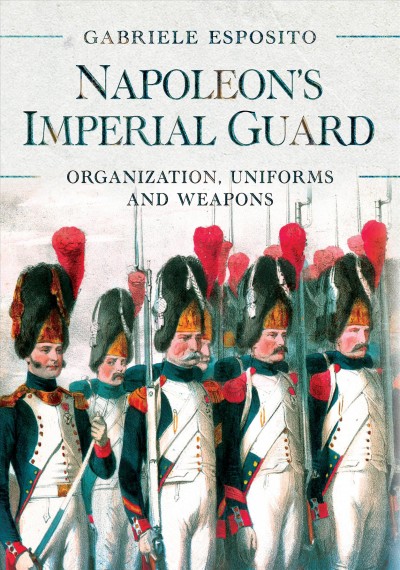Book
Review:
Napoleon's Imperial Guard:
Organization, Uniforms and Weapons
By Gabriele Esposito


One of the most famous fighting forces of all time is Napoleon Bonaparte's Imperial Guard, a formidable formation that was the backbone of the Grande Armee during its greatest days.
The Guard grew from a unit known as the Consular Guard, which had been formed by combining two existing corps — the Guard of the Directorate and the Guard of the Legislative Corps — and adding in a sizeable number of experienced troops.
In Gabriele Esposito's Napoleon's Imperial Guard he examines this elite unit as it grew from some 3600 men before 1801, into a massive army of its own numbering 100,000 soldiers by the 1812 campaign in Russia.
To build this army within an army and maintain its elite status France had a rigid set of standards for troops wanting to join the Guard and, in particular, the Foot Grenadiers and Foot Chasseurs.
A grenadier had to be over 25, between 1.78 and 1.84 metres tall, fit, healthy, and served in three campaigns. A chasseur could be slightly shorter at 1.7m.
New to me was the stipulation they also had to be literate.
In exchange for their loyalty the guardsmen got the best uniforms, food, and twice as much pay as similar ranks in other units.
During Napoleon's early campaigns his Guard fought as elite troops, but from 1806 onwards the Emperor protected his favourites more and more. Les grognards, or Grumblers, were not best pleased with being left out of the action.
Esposito produces good, solid books on his subjects and presents the targets of his focus in a defined clear way.
The units are: The Consular Guard, The Foot Grenadiers and Foot Chasseurs, Infantry of the Middle Guard and Young Guard, Mounted Grenadiers, Mounted Chasseurs, Empress' Dragoons, Polish Lancers, Dutch Lancers, German and Lithuanian Lancers, Guards of Honour and Scouts, Mamelukes and Tartars, Sailors and Gendarmerie, Artillery and Train.
In Napoleon's Imperial Guard the really impressive thing is the colour plates of troops in various uniforms. Taken from the Vinkhuijzen Collection of Military Uniforms they bring the troops he is writing about to life.
-
Richard Moore
7/10
Napoleon's Imperial Guard: Organization, Uniforms and Weapons, by Gabriele Esposito.
Pen and Sword Books, ISBN: 1526786710.
Pages: 143.
Illustrations: 58 colour images.